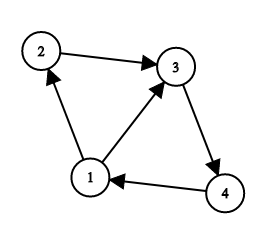CF1204C.Anna, Svyatoslav and Maps
普及/提高-
通过率:0%
AC君温馨提醒
该题目为【codeforces】题库的题目,您提交的代码将被提交至codeforces进行远程评测,并由ACGO抓取测评结果后进行展示。由于远程测评的测评机由其他平台提供,我们无法保证该服务的稳定性,若提交后无反应,请等待一段时间后再进行重试。
题目描述
The main characters have been omitted to be short.
You are given a directed unweighted graph without loops with n vertexes and a path in it (that path is not necessary simple) given by a sequence p1,p2,…,pm of m vertexes; for each 1≤i<m there is an arc from pi to pi+1 .
Define the sequence v1,v2,…,vk of k vertexes as good, if v is a subsequence of p , v1=p1 , vk=pm , and p is one of the shortest paths passing through the vertexes v1 , … , vk in that order.
A sequence a is a subsequence of a sequence b if a can be obtained from b by deletion of several (possibly, zero or all) elements. It is obvious that the sequence p is good but your task is to find the shortest good subsequence.
If there are multiple shortest good subsequences, output any of them.
输入格式
The first line contains a single integer n ( 2≤n≤100 ) — the number of vertexes in a graph.
The next n lines define the graph by an adjacency matrix: the j -th character in the i -st line is equal to 1 if there is an arc from vertex i to the vertex j else it is equal to 0 . It is guaranteed that the graph doesn't contain loops.
The next line contains a single integer m ( 2≤m≤106 ) — the number of vertexes in the path.
The next line contains m integers p1,p2,…,pm ( 1≤pi≤n ) — the sequence of vertexes in the path. It is guaranteed that for any 1≤i<m there is an arc from pi to pi+1 .
输出格式
In the first line output a single integer k ( 2≤k≤m ) — the length of the shortest good subsequence. In the second line output k integers v1 , … , vk ( 1≤vi≤n ) — the vertexes in the subsequence. If there are multiple shortest subsequences, print any. Any two consecutive numbers should be distinct.
输入输出样例
输入#1
4 0110 0010 0001 1000 4 1 2 3 4
输出#1
3 1 2 4
输入#2
4 0110 0010 1001 1000 20 1 2 3 4 1 2 3 4 1 2 3 4 1 2 3 4 1 2 3 4
输出#2
11 1 2 4 2 4 2 4 2 4 2 4
输入#3
3 011 101 110 7 1 2 3 1 3 2 1
输出#3
7 1 2 3 1 3 2 1
输入#4
4 0110 0001 0001 1000 3 1 2 4
输出#4
2 1 4
说明/提示
Below you can see the graph from the first example:

The given path is passing through vertexes 1 , 2 , 3 , 4 . The sequence 1−2−4 is good because it is the subsequence of the given path, its first and the last elements are equal to the first and the last elements of the given path respectively, and the shortest path passing through vertexes 1 , 2 and 4 in that order is 1−2−3−4 . Note that subsequences 1−4 and 1−3−4 aren't good because in both cases the shortest path passing through the vertexes of these sequences is 1−3−4 .
In the third example, the graph is full so any sequence of vertexes in which any two consecutive elements are distinct defines a path consisting of the same number of vertexes.
In the fourth example, the paths 1−2−4 and 1−3−4 are the shortest paths passing through the vertexes 1 and 4 .